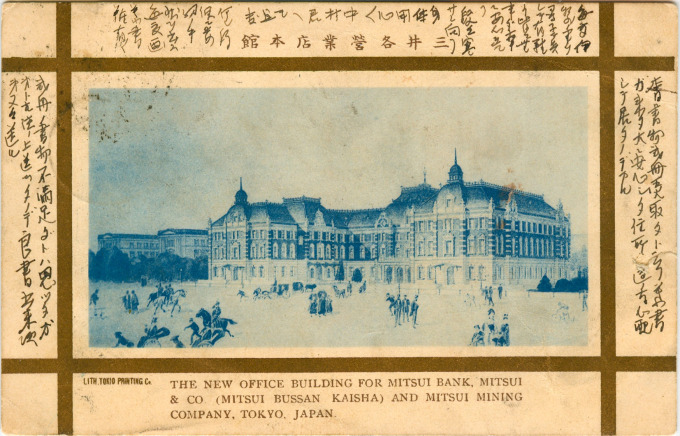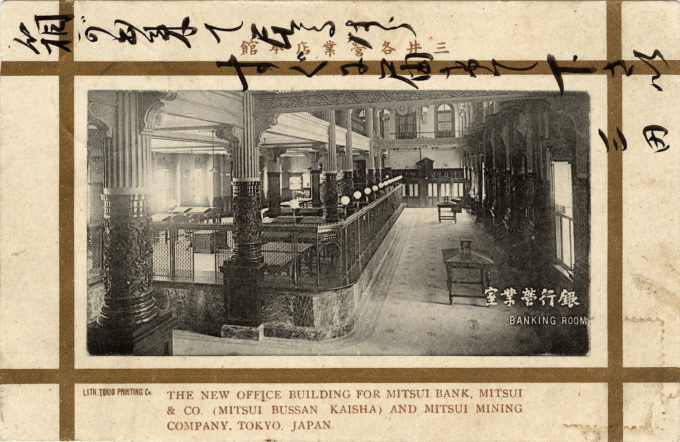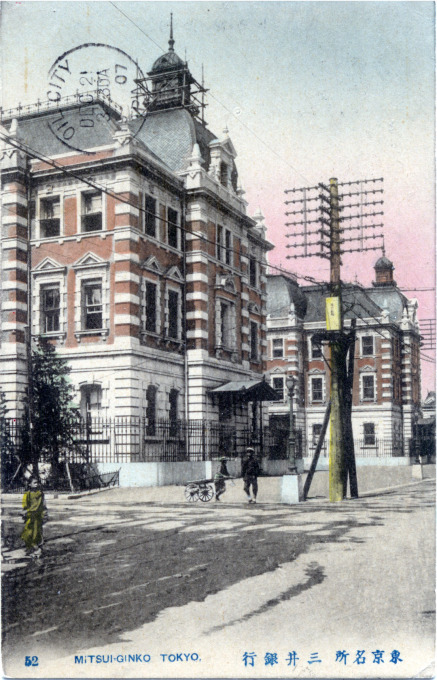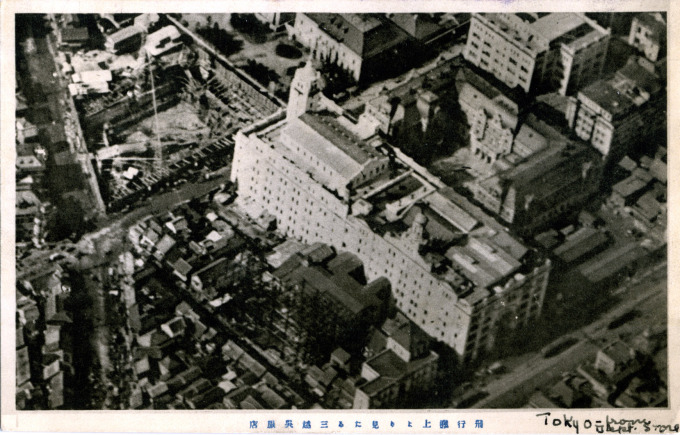
“The new office building for Mitsui Bank, Mitsui & Co. (Mitsui Bussan Kaisha), and Mitsui Mining Company,” at Nihonbashi, c. 1905. The Mitsui family began banking operations in 1683, when the Tokugawa Shogunate granted Mitsui Takatoshi permission to act as a money changer. Mitsui Bank was incorporated as a private company in July 1876, and was one of the Japanese government’s main banks for deposits and tax collections until the formation of the Bank of Japan in 1882.
See also:
Nippon Ginko (Bank of Japan) & Mitsui Bank, Nihonbashi, c. 1910.
Yokohama Specie Bank, Yokohama, c. 1920.
“The 1876 revisions of the National Bank Decree allowed would-be bankers to use the title ‘bank’, but it was only Mitsui who would immediately take this opportunity to establish themselves as a western-style modern bank. (Mitsui had earlier in 1872 planned to set up their own bank but were persuaded to support the government scheme of bringing about a national bank system.) In April 1876, Mitsui drafted the prospectus entitled The Case for the Establishment of Mitsui Bank which was accepted by the Finance Ministry. Mitsui Bank opened its doors on the first day of July 1876.
“In the prospectus, Mitsui were proud of ‘the business of the house of Mitsui being in existent for several hundred years.’ [But,] the ancient, distinguished name of Mitsui Gumi [‘group’] was abandoned without hesitation and the new business launched with the simple name ‘Mitsui Bank’.”
– Japanese Banking: A History, 1859-1959, by Norio Tamaki, 2005

“The new office building for Mitsui Bank, Mitsui & Co. (Mitsui Bussan Kaisha) and Mitsui Mining Company”, Nihonbashi, Tokyo, c. 1905.
“The Mitsui Bank Limited, recently reconstituted as a joint stock company, is one of the oldest and the largest institutions in the Empire of Japan. It has grown out of the Mitsui Exchange House founded at Kyoto, Osaka and Yedo (now Tokyo) by Takatoshi Mitsui over two centuries ago.
“The celebrated financier invented and organised for the first time in Japan a special banking system, and this, be it remembered, was done when the knowledge of banking or bills of exchange was entirely lacking in [Great Britain], and when in England the business of modern banking was first introduced by the New Fashioned Goldsmiths or Bankers in London. (It is to be noted that the Bank of England which has been the principal bank not only in England but in the whole world, was projected by William Paterson and incorporated in England just three years after the appointment of Takahira, the eldest son of Takatoshi, by the Tokugawa Shogunate as its Exchange Controller in 1631.)
“With the Restoration of Meiji, an important epoch was opened in the history of the firm. While the new government under the direct control of the Crown was in process of consolidation, the Mitsuis acted as its principal financing agents and it was in a great measure due to this that the country was enabled to bridge over a great crisis with which it was then threatened from within and without.
“… At that time, the Mitsui Exchange House had already been projecting the transformation of its institution into a central bank of Japan, but in the meanwhile, the Government adopting the American banking system, the National Bank Act was promulgated. In 1872, the First National Bank was established at Tokyo, and the Mitsuis became its principal share-holders. Thus although the Mitsuis had to abandon their project, they never ceased to be a prominent power in the financial dominion of the country.
“In 1876, the Mitsui Bank was organized, upon having revised and enlarged not only the original business of the Exchange House , but also its general banking transactions, which were increased to a vast extent. In 1893, by the enactment of the Commercial Code, the Mitsui Bank was remodelled to an unlimited liability concern.”
– Japan To-day: A Souvenir of the Anglo-Japanese Exhibition Held in London 1910, by Kotaro Mochizuki, Liberal News Agency, Tokyo, 1910





Pingback: Nippon Ginko (Bank of Japan) & Mitsui Bank, Nihonbashi, c. 1910. | Old Tokyo
Pingback: Okura Kumi (Okura Partners), Ginza, 1921. | Old Tokyo
Pingback: Mitsui Bank, Nihonbashi, c. 1930. | Old Tokyo
Pingback: “Mitsui Salicylic Acid”, Miike Dye Works, Mitsui Mining Co., Omuta, Kyushu, c. 1928. | Old TokyoOld Tokyo
Pingback: Gifu Prefectural Museum of Natural Resources, Gifu City, Gifu Prefecture, 1908. (Colorized) | Old Tokyo